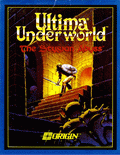
































Ultima Underworld: The Stygian Abyss

Ultima Underworld: The Stygian Abyss is a first-person role-playing video game (RPG) developed by Blue Sky Productions (later Looking Glass Studios) and published by Origin Systems. Released in March 1992, the game is set in the fantasy world of the Ultima series. It takes place inside the Great Stygian Abyss: a large, underground cave system that contains the remnants of a failed utopian civilization. The player assumes the role of the Avatar—the Ultima series' protagonist—and attempts to find and rescue a baron's kidnapped daughter.
Ultima Underworld has been cited as the first role-playing game to feature first-person action in a 3D environment, and it introduced technological innovations such as allowing the player to look up and down. Its design combines simulation elements with concepts from earlier CRPGs, including Wizardry and Dungeon Master, which led the game's designers to call it a 'dungeon simulation'. As such, the game is non-linear and allows for emergent gameplay.
Ultima Underworld received widespread critical acclaim and sold nearly 500,000 units. The game was later placed on numerous hall of fame lists. It influenced game developers such as Bethesda Softworks and Valve Corporation, and it was an inspiration behind the games Deus Ex and BioShock. The game has one sequel: Ultima Underworld II: Labyrinth of Worlds (1993).
Ultima Underworld is a role-playing video game (RPG) that takes place from a first-person perspective in a three-dimensional environment. The player's goal is to adventure through a large, multi-level dungeon, in which the entire game is set. The player uses a freely movable mouse cursor to interact with the game's world, and with the icon-based interface on the heads-up display (HUD). Each icon has a specific effect; for example, the Look icon allows the player to examine objects closely, while the Fight icon causes the player character to ready its weapon. The player's progression through the game is non-linear: areas may be explored, and puzzles and quests finished, in any order. An automatically filling map, to which the player may add notes, records what the player has seen above a minimum level of brightness. The player character may carry light sources to extend the line of sight in varying amounts. Exploratory actions include looking up and down, jumping, and swimming.
The player begins the game by creating a character, for whom traits such as gender, class and skills may be selected. Skills range from fighting with an axe, to bartering, to picking locks. By participating in combat, quests and exploration, the character gains experience points. When certain amounts of experience points are accumulated, the character levels up, gaining additional hit points and mana. Experience also allows the player to recite mantras at shrines in the game. Each mantra is a statement—such as 'Om Cah'—that increases proficiency in a specific skill when typed. Simple mantras are provided in the game's manual, while more complex ones are hidden throughout the game. An inventory on the HUD lists the items and weapons currently carried by the player character; capacity is limited by weight. Players equip items via a paper doll system, wherein items are clicked-and-dragged onto a representation of the player character.
Combat occurs in real-time, and the player character may use both melee and ranged weapons. The player attacks by holding the cursor over the game screen and clicking, depressing the button longer to inflict greater damage. Some weapons allow for different types of attacks depending on where the cursor is held; for example, clicking near the bottom of the screen may result in a jab, while clicking in the middle produces a slash. Simulated dice rolls occur behind the scenes to determine weapon accuracy. Enemies sometimes try to escape when near death, and the game's stealth mechanics may occasionally be used to avoid combat altogether. The player may cast spells by selecting an appropriate combination of runestones. Like mantras, runestones must be found in the game world before use. There are over forty spells, some undocumented; their effects range from causing earthquakes to allowing the player character to fly.
The developers intended Ultima Underworld to be a realistic and interactive 'dungeon simulation', rather than a straightforward role-playing game. For example, many objects in the game have no actual use, while a lit torch may be used on corn to create popcorn. Weapons deteriorate with use, and the player character must eat and rest; light sources burn out unless extinguished before sleeping. A physics system allows, among other things, for items to bounce when thrown against surfaces. The game contains non-player characters (NPCs) with whom the player may interact by selecting dialogue choices from a menu. Most NPCs have possessions, and are willing to trade them. The game was designed to give players 'a palette of strategies' with which to approach situations, and its simulation systems allow for emergent gameplay.
How to play:
Click on the joystick icon in the Ultima Underworld: The Stygian Abyss online emulator to see how to control the Ultima Underworld: The Stygian Abyss game









































Comments